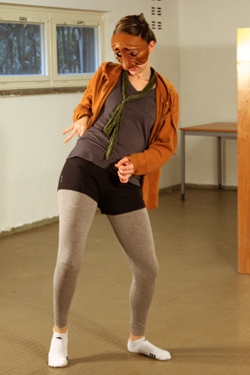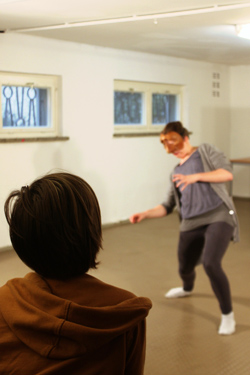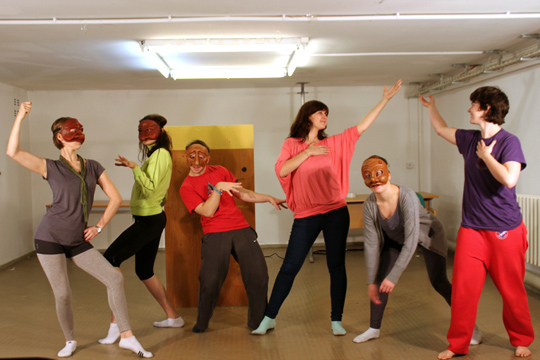
Every actor has to constantly try on imaginary masks in order to get used to one role or another. My personal experience of wearing a real mask hovers around playing a fox at a school masquerade and being a phlegmatic zombie at some random Halloween party. But how about wearing a big and stifling mask while speaking, singing, dancing and jumping within a two-hour stage performance? Commedia dell’Arte turned out to be a magnificent way to appeal artistically to the audience, and one of the most physically exhausting, unique and hilarious theatrical practices that I have ever experienced.
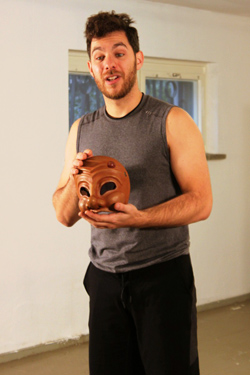
On a late autumn Sunday morning, we warmly welcomed at ECLA of Bard’s art garage Jon Stancato, Resident Director of the Stolen Chair Theatre Company. Jon teaches playwriting, directing, acting, and physical theatre techniques, paying special attention to the genre of Commedia dell’Arte. He came to ECLA of Bard to present the history of this peculiar genre and to show a few basic staging and acting principles.
Commedia dell’Arte is a type of Italian improvisational theatre which became popular in the XVI century. Performances were presented in the street and in main squares, on temporary stages built by actor troupes moving from town to town. It was one of the main entertainment forms for the urban poor who wanted to make fun of authority and relax after the day’s hard work. The entrance was obviously free, and donations were highly appreciated, since they were the main means of subsistence for the actors.
To make the jokes relevant and sharp, the troupes sent a few people ahead to the local bars to overhear the gossips and to identify some public personas to make fun of in the particular towns. The main task of the actors was to make people laugh, as no one would give a reward for sad stories, drama or serious self-reflection. In general, the performances of Commedia dell’Arte were supposed to be simple, funny in an accessible way and a bit overplayed.
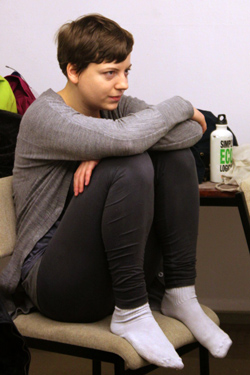
This genre is based on the consequence of action and reaction: every action performed by an actor on stage should be followed by a deep breath, exhalation and his/her response to the situation. At first it felt weird and exaggerated, but later I got used to living out all the wide range of emotions publicly. The main rule of Commedia dell’Arte – you can never stay indifferent!
After a few funny warming up exercises, we started to get acquainted with the masks. According to Jon, actors usually choose their favorite masks and keep playing them throughout the entire career, perfecting their technique. Particular roles also require a great physical condition, so performers usually combine acting work with gymnastics and acrobatics.
One of the characters, Arlecchino, comes from the zanni – a comic group of servants. Arlecchino mostly acts as a weak-minded fool – he burps, farts, speaks in a dumb voice and cheers up the audience as soon as they get bored. He is also always hungry because he rarely gets paid for the performance.
Having demonstrated the specific body movements and speaking manner of this character, Jon invited willing students to play a small improvisational piece wearing an Arlecchino mask. The newly turned actors presented the character and performed an acting task involving an imaginary fly. Hungry Arlecchino was supposed to eat a bug while narrating his actions.
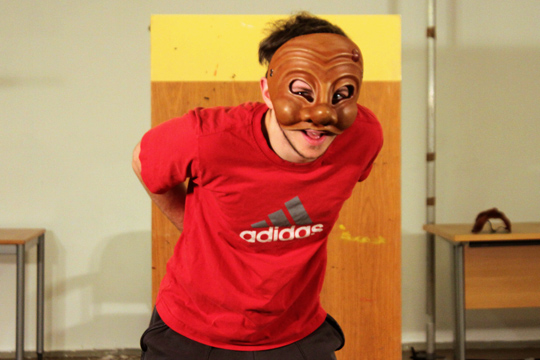
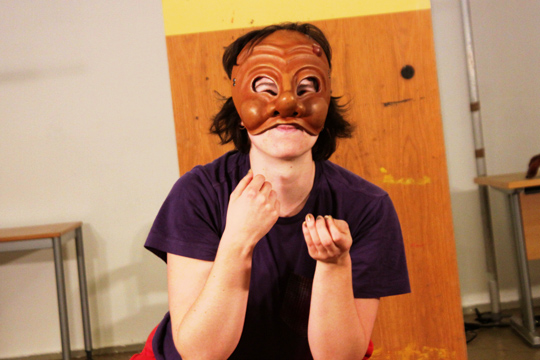 Pantalone, another personage of Commedia dell’Arte, is keen on money. He moves slowly and looks old and ill, but nevertheless hits on young ladies and can make a backflip when he finds a coin. All his coins have sweet names and are carried in a special bag attached to the belt. The imaginary fly makes him lose all his money and he starts collecting it from the floor, grunting and cursing.
Pantalone, another personage of Commedia dell’Arte, is keen on money. He moves slowly and looks old and ill, but nevertheless hits on young ladies and can make a backflip when he finds a coin. All his coins have sweet names and are carried in a special bag attached to the belt. The imaginary fly makes him lose all his money and he starts collecting it from the floor, grunting and cursing.
Spanish Capitano is brutal, loud and overconfident. He adores telling stories about his brave battles with numerous victims and about his victories on the love front. Capitano threatens those who laugh at him, but runs away in panic as soon as he hears the buzz of a little fly.
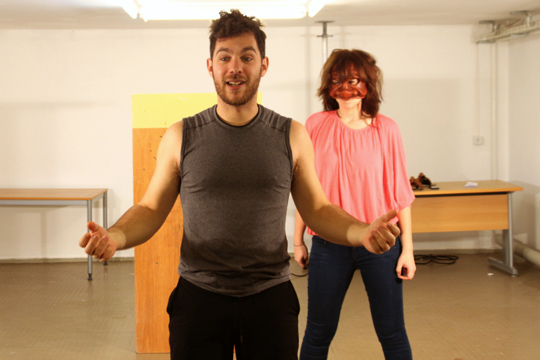
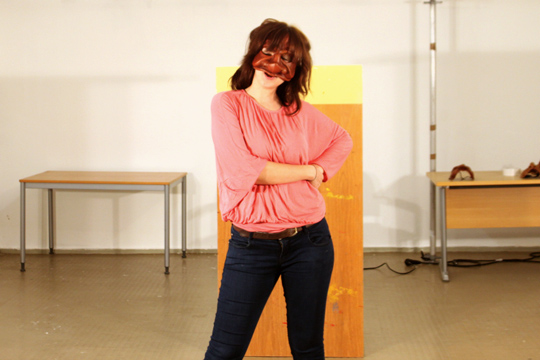 The Lovers (Innamorati) don’t have special masks and always perform as a couple. Their speech is rich in epithets and elegant words. When meeting on stage, they first accuse each other, but end up holding hands and exchanging sophisticated compliments.
The Lovers (Innamorati) don’t have special masks and always perform as a couple. Their speech is rich in epithets and elegant words. When meeting on stage, they first accuse each other, but end up holding hands and exchanging sophisticated compliments.
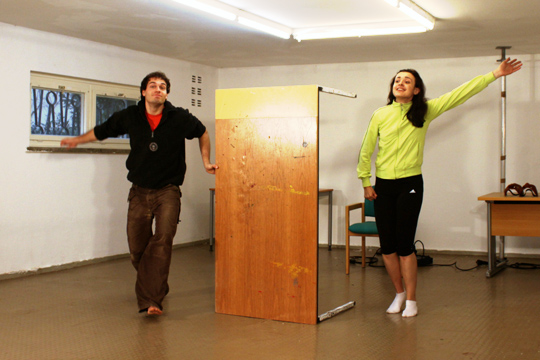
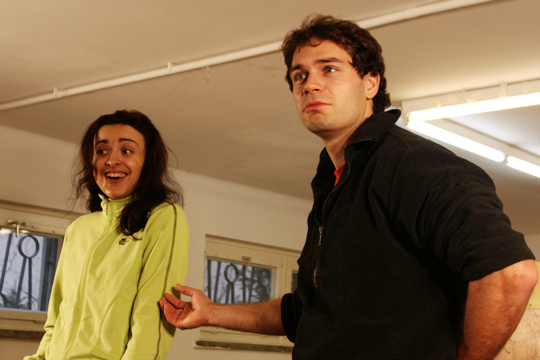 At the end of the workshop we created a group performance with almost all of the characters. The action took place in a night club, and I should say that putting classic Commedia dell’Arte personages in a modern setting made them even more amusing and absurd. Even though the masks were quite stifling and didn’t exactly fit – one could barely see through them – we couldn’t help laughing and posing funny faces which nobody could see under the cover.
At the end of the workshop we created a group performance with almost all of the characters. The action took place in a night club, and I should say that putting classic Commedia dell’Arte personages in a modern setting made them even more amusing and absurd. Even though the masks were quite stifling and didn’t exactly fit – one could barely see through them – we couldn’t help laughing and posing funny faces which nobody could see under the cover.
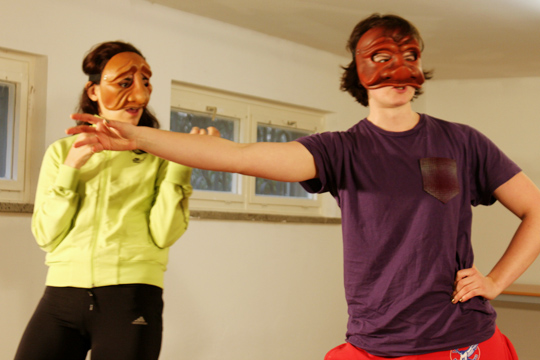
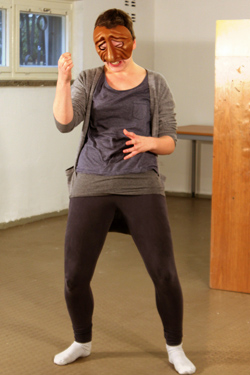
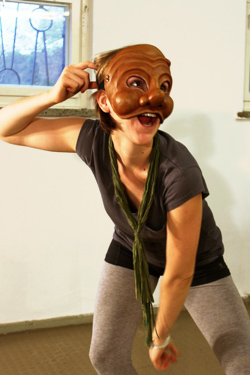 Commedia dell’Arte is not a genre which appeals to everyone. Its overplayed and grotesque character can be annoying, and in addition it may seem too primitive at first sight. For the actor, this theatre technique is challenging: you have to get rid of personal feelings and internal sufferings, and share every single emotion with the audience, emphasizing it to the absurd. But using the entire impressive list of Commedia dell’Arte masks (which consists of more than 100), it is possible to create a truly ridiculous political parody or even a humorous rendition of the late night news. In any case, the workshop was a splendid acting practice which helped me feel more at ease on stage and pay more attention to each action, even in everyday life.
Commedia dell’Arte is not a genre which appeals to everyone. Its overplayed and grotesque character can be annoying, and in addition it may seem too primitive at first sight. For the actor, this theatre technique is challenging: you have to get rid of personal feelings and internal sufferings, and share every single emotion with the audience, emphasizing it to the absurd. But using the entire impressive list of Commedia dell’Arte masks (which consists of more than 100), it is possible to create a truly ridiculous political parody or even a humorous rendition of the late night news. In any case, the workshop was a splendid acting practice which helped me feel more at ease on stage and pay more attention to each action, even in everyday life.
All photos by Valerie Pochko

